
Cheddar cheese is a natural cheese that is relatively hard, off-white, and sometimes sharp-tasting. Cheddar originates from the English village of Cheddar in Somerset.

Dairy products or milk products, also known as lacticinia, are food products made from milk. The most common dairy animals are cow, water buffalo, nanny goat, and ewe. Dairy products include common grocery store food items in the Western world such as yogurt, cheese and butter. A facility that produces dairy products is known as a dairy. Dairy products are consumed worldwide to varying degrees. Some people avoid some or all dairy products either because of lactose intolerance, veganism, or other health reasons or beliefs.

Brie is a soft cow's-milk cheese named after Brie, the French region from which it originated. It is pale in color with a slight grayish tinge under a rind of white mould. The rind is typically eaten, with its flavor depending largely upon the ingredients used and its manufacturing environment. It is similar to Camembert, which is native to a different region of France. Brie typically contains between 60% and 75% butterfat, slightly higher than Camembert.
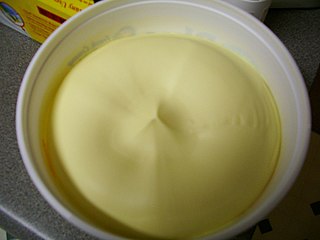
Margarine is a spread used for flavoring, baking, and cooking. It is most often used as a substitute for butter. Although originally made from animal fats, most margarine consumed today is made from vegetable oil. The spread was originally named oleomargarine from Latin for oleum and Greek margarite. The name was later shortened to margarine.

Buttermilk is a fermented dairy drink. Traditionally, it was the liquid left behind after churning butter out of cultured cream. As most modern butter in western countries is not made with cultured cream but uncultured sweet cream, most modern buttermilk in western countries is cultured separately. It is common in warm climates where unrefrigerated milk sours quickly.

Processed cheese is a food product made from cheese and unfermented dairy ingredients mixed with emulsifiers. Additional ingredients, such as vegetable oils, salt, food coloring, or sugar may be included. As a result, many flavors, colors, and textures of processed cheese exist. Processed cheese typically contains around 50 to 60% traditional cheese.

Colby is a semi-hard orange cheese made from cow's milk. It is named after the city of Colby, Wisconsin, US, where it was first developed in 1885 and quickly became popular.

Skyr is an Icelandic cultured dairy product originating in Norway. It has the consistency of strained yogurt, but a milder flavor. Skyr can be classified as a fresh sour milk cheese, similar to curd cheese consumed like a yogurt in the Baltic states, the Low Countries, Germany and Russia. It has been a part of Icelandic cuisine for centuries.

Buffalo mozzarella is a mozzarella made from the milk of Italian Mediterranean buffalo. It is a dairy product traditionally manufactured in Campania, especially in the provinces of Caserta and Salerno.
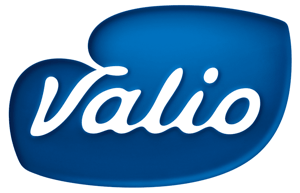
Valio Ltd is a Finnish manufacturer of dairy products and one of the largest companies in Finland. Valio's products include cheese, powdered ingredients, butter, yogurt and milk. It is Finland's largest milk processor, producing 85% of the country's milk.
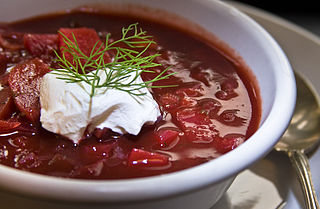
Smetana is a type of sour cream from Central and Eastern Europe. It is a dairy product produced by souring heavy cream. It is similar to crème fraîche, but nowadays mainly sold with 9% to 42% milkfat content depending on the country. Its cooking properties are different from crème fraîche and the lighter sour creams sold in the US, which contain 12 to 16% butterfat. It is widely used in cooking and baking.

Sulguni is a brined Georgian cheese from the Svaneti and Samegrelo regions. It has a sour, moderately salty flavor, a dimpled texture, and an elastic consistency; these attributes are the result of the process used, as is the source of its nickname "pickle cheese". Its color ranges from white to pale yellow. Sulguni is often deep-fried, which masks its odor. It is often served in wedges.
Santarém is a goat cheese from Portugal produced in several different regions, most notably in the Santarém district and in Serra de Santo António in the Ribatejo province of Portugal.

Koryciński, also known as "Swojski" (homemade), is a hard cheese made from cow's milk, named after the village of Korycin in Poland, and made in the Podlaskie Voivodeship in eastern Poland. In the traditional technique of producing the cheese, dried and powderized veal stomachs were used as rennet. The cheese takes the form of a flattened ball with a diameter of 30 cm and weight of 3 kg. Normally, around 25 litres of milk are used to produce it. It is considered to be the oldest Polish cheese. Currently, different varieties of the cheese are produced, most notably the ones with herbs and garlic added as ingredients.
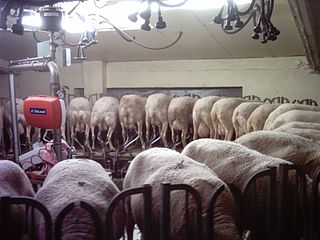
Sheep's milk is the milk of domestic sheep. It is commonly used to make cultured dairy products such as cheese. Some of the most popular sheep cheeses include feta (Greece), ricotta (Italy), and Roquefort (France).

Montasio is a mountain cheese made from cow's milk produced in northeastern Italy in the regions of Friuli-Venezia Giulia and Veneto.
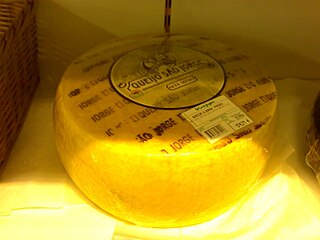
São Jorge Cheese is a semi-hard to hard cheese, produced on the island of São Jorge, in the Portuguese archipelago of the Azores, certified as a Região Demarcada do Queijo de São Jorge and regulated as a registered Denominação de Origem Protegida.

Vegan cheese is a category of non-dairy, plant-based cheese analogues. Vegan cheeses range from soft fresh cheeses to aged and cultured hard grateable cheeses like plant-based Parmesan. The defining characteristic of vegan cheese is the exclusion of all animal products.
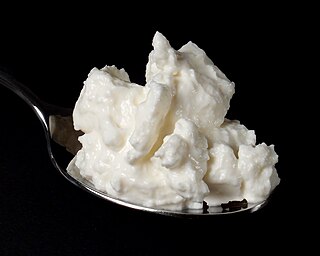
Quark or quarg is a type of fresh dairy product made from milk. The milk is soured, usually by adding lactic acid bacteria cultures, and strained once the desired curdling is achieved. It can be classified as fresh acid-set cheese. Traditional quark can be made without rennet, but in modern dairies small quantities of rennet are typically added. It is soft, white and unaged, and usually has no salt added. It is traditional in the cuisines of Baltic, Germanic and Slavic-speaking countries as well as amongst Ashkenazi Jews and various Turkic peoples.


















